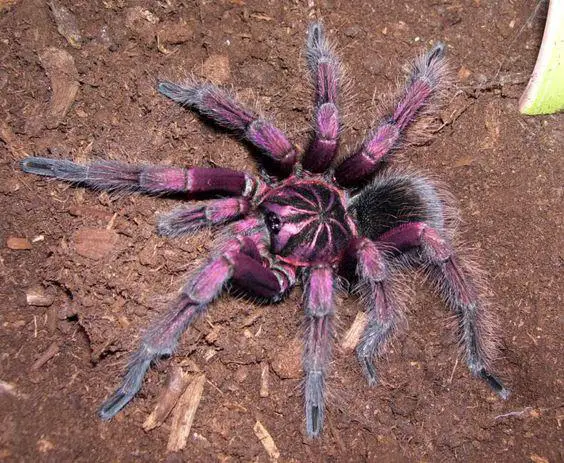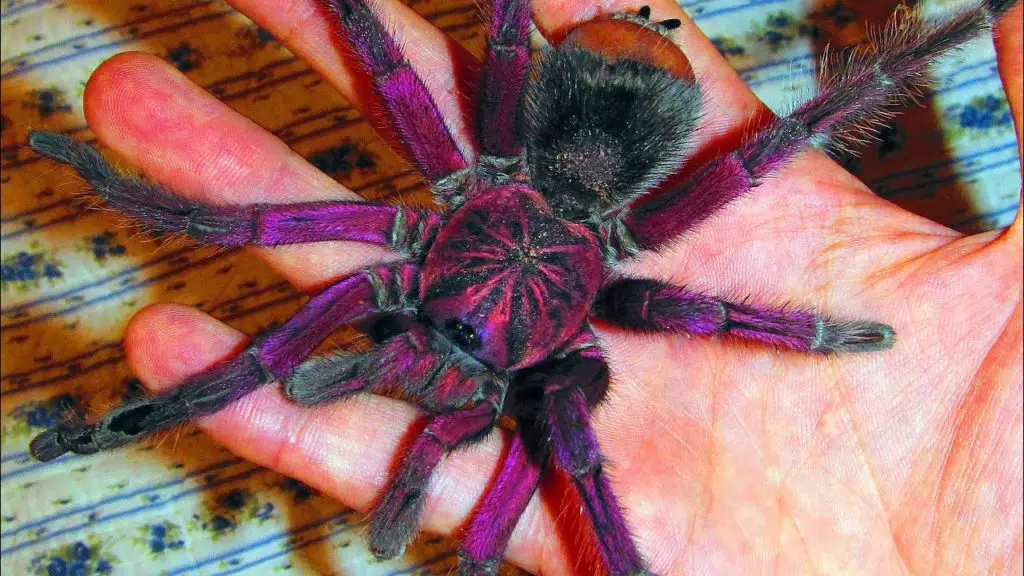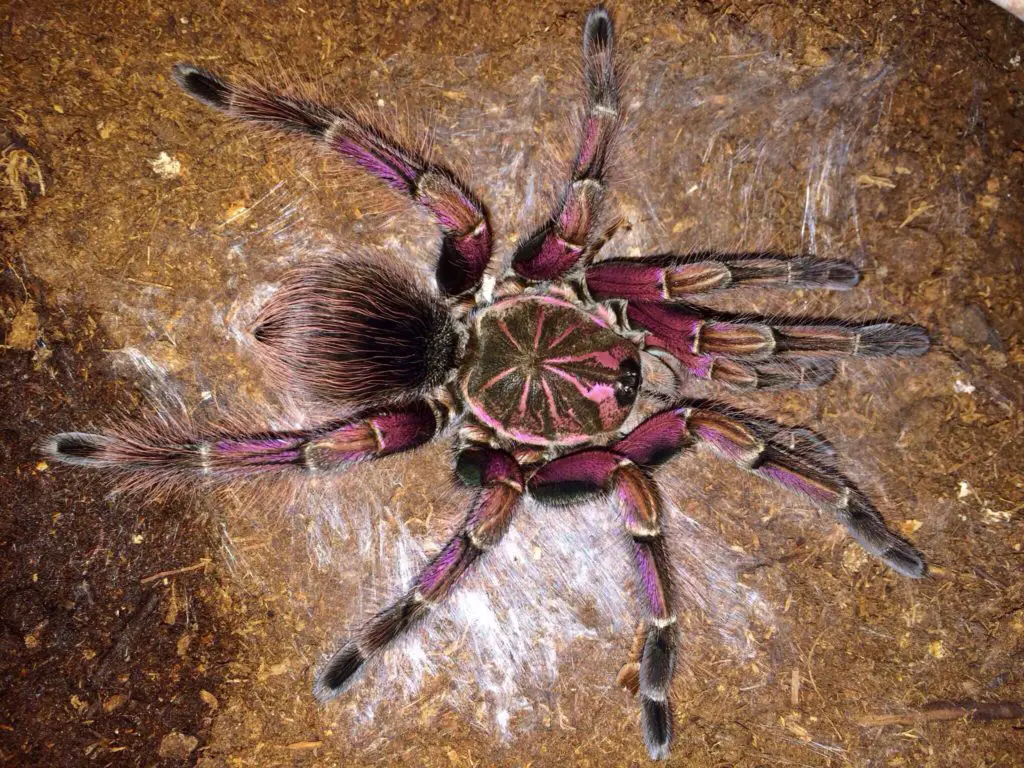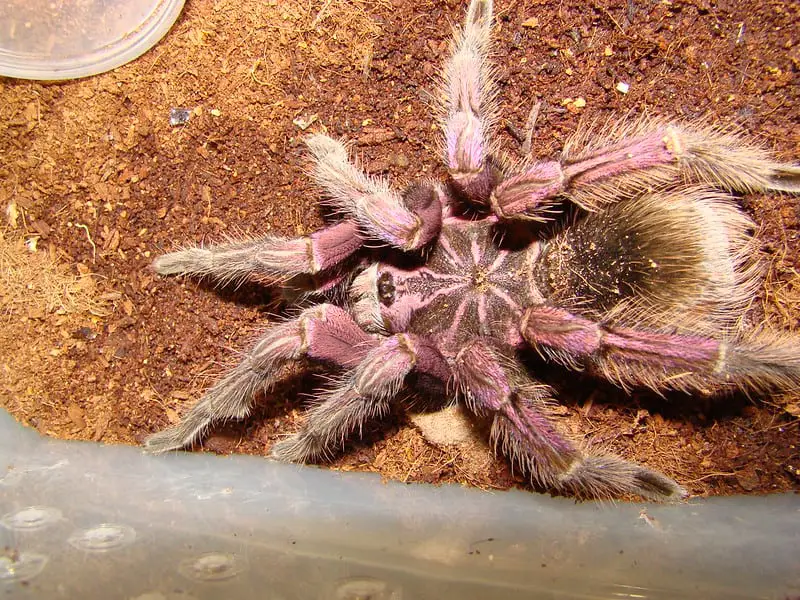The Brazilian Pink Bloom Tarantula (Pamphobeteus sp. Platyomma) is a terrestrial New World species found in Ecuador and Brazil. The beautiful bright pink and purple colors displayed by the males of this species make them a popular choice for pets.
If you’re considering buying a new tarantula as a companion, here’s what you need to know about this species to make sure if this colorful spider is the right fit for you.

Brazilian Pink Bloom Tarantula Care Sheet
| Species Name | Pamphobeteus sp. Platyomma |
| Family Name | Theraphosidae |
| Common Name | Brazilian Pink Bloom |
| Category | New World |
| Type | Terrestrial Opportunistic Burrower |
| Native Location | Ecuador |
| Body Length | 3.5 inches (9cm) |
| Diagonal Leg Span | 8 inches (20cm) |
| Growth Speed | Medium – Fast |
| Urticating Hairs | Yes; Type I and III |
| Diet | Crickets, roaches, mealworms |
| Temperature | 77 to 82 Fahrenheit |
| Humidity | 70 to 80% |
| Life Expectancy | Females: 20 years / Males: 4-5 years |
| Recommended Experience Level | Intermediate |
| Minimum tank size | 5 to 10 gallons |
Brazilian Pink Bloom Tarantula Overview
The Pamphobeteus sp. Platyomma, commonly known as the Brazilian Pink Bloom Tarantula, is a terrestrial species. It’s often described as a nervous spider, so the careful handling it requires makes it more fit for weathered tarantula owners.
With a body length of 3.5 inches and a leg span of 8 inches, this is quite a large tarantula that feeds on insects and even small mammals when given the chance.
Appearance

The Brazilian Pink Bloom Tarantula is undoubtedly one of the top spiders when it comes to color and beauty. These spiders exhibit sexual dimorphism, with the males being the ones with the flashy colors and the females having a more natural dark brown color.
Though smaller than the females, the males have highlights of bright pink and purple all over the top of their bodies, making them highly desired among collectors.
Behavior and Temperament
As stated above, Brazilian Pink Bloom Tarantulas tend to be nervous. Caretakers report that she’ll go into a defensive stance before retreating rapidly as soon as a hand is placed in the tank.
This is a New World species, as such, they have urticating hairs that they can release when they feel threatened. They’re known for being likely to kick their urticating hairs every time they burrow.
Therefore, it’s highly advised to use protective gloves each time you must enter your hand inside the tank, even if you’re not planning to approach the spider.
They do not tend to bite, instead preferring to run away from threats. However, continuous provocation can lead to a threat pose and eventually a bite. Luckily, their venom is weak and does not pose a threat to humans without allergies.
Price
The cost of a Brazilian Pink Bloom Tarantula depends on the sex and the developmental stage of the specimen. A sling can go as low as $40, while the price of adult females can rise to a staggering $400.
Adult males typically cost half as much as females because females live much longer, making them better value for money.
Caring for a Brazilian Pink Bloom Tarantula

Substrate
The Brazilian Pink Bloom Tarantula is an opportunistic burrower, which means she needs enough substrate to burrow into. She’ll also appreciate a piece of bark or something else to use as a temporal burrow.
For substrates, it’s good to use soft soil such as coco fiber and organic topsoil. You can also add peat moss or even some dirt for firmness. It’s good as long as you make sure there is no pesticide.
The substrate needs to be deep enough so the spider will have a place to burrow comfortably. Three inches of substrate for spiderlings and younglings and at least four inches for adults should be enough.
Tank setup
The tank must have at least five to ten gallons for adults. It should also be much wider than it is tall to keep the Brazilian Pink Bloom Tarantula from falling long distances and harming itself.
Of course, you should maintain a water dish inside the tank and make sure it’s always full. The substrate should be watered at least twice a month to keep it moist and fresh.
Temperature & Humidity
Ecuador is a tropical country with temperatures that don’t go lower than 55°F and usually are around 78°F. Therefore, it’s ideal to have these spiders in a room between 70°F and 80°F, with 70% – 80% humidity.
Higher temperatures and humidity make them grow faster and typically make the spider more active. However, raising the temperature too high is not good for them. Adequate ventilation is also important.
Diet
The BPBT is large enough to eat rodents and small birds in the wild, but she’ll be happy eating crickets and roaches in captivity. You can still feed her small mice every once in a while, but crickets are enough to feed her plenty.
Slings must be fed larvae. Common larvae such as flour beetle larvae work, but you can also provide them with fruit fly larvae.
Once they get over half an inch, it’s time to start feeding them one small cricket twice a week. Pre-adult spiders, or juveniles, could have one or two medium-sized crickets twice a week, depending on their size.
As for adults, three to five large crickets twice a week should be enough, depending on their appetites and the size of their abdomens. They’re very enthusiastic eaters, so watching them eat is always fun. They hardly reject a meal unless they’re about to molt, and in ideal circumstances, they’ll eat more and grow faster.
Lifespan & Health
The Brazilian Pink Bloom Tarantula has a long lifespan. Females can live for up to 20 years while males typically live for around 4 to 5 years.
To keep them alive and healthy, there are a few important things to keep in mind.
First, make sure that the feeder insects are from a good source and are captive-bred. Wild-caught insects are often infested with parasites that can transfer to your tarantula.
Second, make sure that you keep their enclosure in good shape. Since these spiders enjoy high humidity the climate in their enclosure is susceptible to mold growth. You need to provide ample ventilation and remove uneaten food within 24 hours to prevent it from rotting. You could also set up a bioactive enclosure.
Lastly, this is a big terrestrial species so if you’re handling them, be careful. Falls can be lethal.
Communal living
While some species like the Socotra Island Blue Baboon can live communally, the Brazilian Pink Bloom cannot. They’re completely solitary species and attempting to house them communally will end in cannibalism.
Make sure that you stick to 1 tarantula per enclosure!
Breeding the Brazilian Pink Bloom Tarantula

Breeding requires a tank with enough space and the ideal circumstances so both adults can feel comfortable. If you already have your BPBTs in tanks of at least 5 gallons, that’s enough space for the breeding to happen. You’ll also want to make sure the substrate is moist, the temperature is warm, the humidity is up, and they’re both adequately fed.
Breeding should happen 4 – 6 weeks after the female has molted to avoid molting between the mating process and the laying of the eggs. If not, the eggs may be unfertilized and the process lost.
Once the egg sack is laid, you should wait at least thirty days before pulling it out and opening it to release the eggs. Take the water cup outside at fifteen days to avoid the spider from tossing the sack into the water to dispose of it, which sometimes happens when part of the eggs start going bad (even if there are still some good ones). By thirty days, you should have primarily slings and first instars. Pull them apart and care for them, as mentioned previously. If you find unhatched eggs, have them in a petri dish with ventilation and humidity so they can hatch, but be careful to set apart any eggs that may have gone bad, so they don’t contaminate the rest.
Please keep in mind that spiders lay many, many eggs which result in many spiderlings being born. Breeding is something that should only be done by experts. If attempted by people who don’t know what they’re doing it might result in dozens of unwanted tarantulas which can be difficult to find good homes for.
Final words: Is the Brazilian Pink Bloom the right Tarantula for You?
We hope this guide gave you everything you needed to know about caring for these beautiful spiders. If you feel like they’re the right fit for you, go for it, you won’t regret it.
However, it should be noted that the Brazilian Pink Bloom is not for everyone. Their skittish and nervous nature combined with their urticating hairs makes them better suited for intermediate to advanced tarantula handlers. Beginners are better off starting with a different species such as the Mexican Red Rump or Arizona Blonde.
- How Long Do American Eskimo Dogs Live? Important Factors and Care Tips - September 29, 2023
- Do American Bulldogs Need Grooming? Essential Tips and Care Guidelines - September 29, 2023
- Do Bengal Cats Enjoy Playing? Essential Tips for Keeping Them Active - September 29, 2023